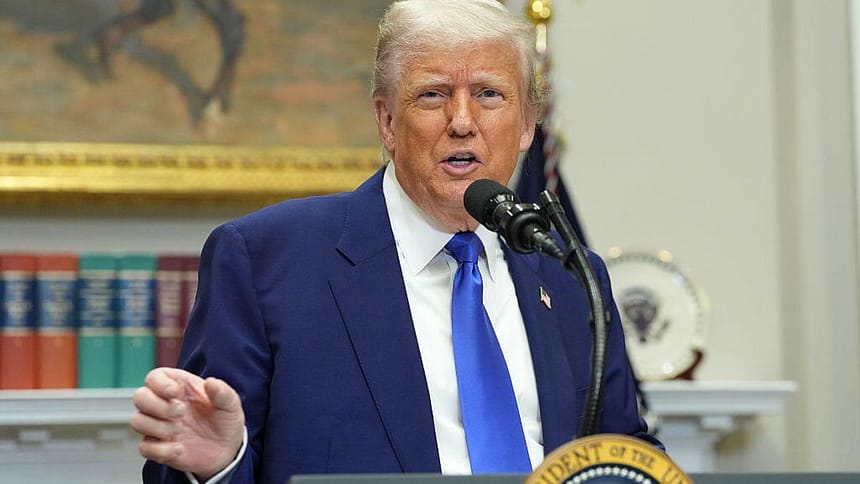President Donald Trump is expected to sign the bipartisan Take It Down Act into law on Monday, a significant step in regulating the nonconsensual sharing of intimate images, including AI-generated deepfakes. The legislation aims to protect individuals from the harmful effects of such content, which has been increasingly prevalent in the digital age with the expansion of artificial intelligence.
Read more: Jamie Lee Curtis Celebrates Meta’s Removal of Fake AI Ad
What are deepfakes?
Deepfakes are realistic but fake images, videos or audio created using artificial intelligence to mimic someone’s appearance, voice or actions.
One widely reported example was a 2022 viral video of Ukraine’s President Volodymyr Zelenskyy. In the altered clip, Zelenskyy appeared to urge Ukrainian soldiers to surrender to Russian forces, a message he never actually delivered. The video was quickly debunked, but it raised serious concerns about the use of deepfakes in disinformation campaigns, especially during wartime.
Deepfakes have also been used to spread sexually explicit content or revenge porn.
“No organization is immune to impersonation attacks,” Matt Moynahan, CEO of GetReal Security, told CNET in an email. “Right now, we are bearing witness to an unprecedented number of AI deepfakes. With the rise of synthetic AI and malicious deepfakes, we can no longer trust our own known experiences. Instead, we must implement tools that integrate greater security at every level and entry point to protect against these looming threats.”
Read more: Election Deepfakes Are Here and Better Than Ever
What are the key aspects of the Take It Down Act?
The Take It Down Act prohibits knowingly sharing or threatening to share intimate images of someone without their permission, including digitally altered or AI-generated deepfakes. Here is a breakdown of the bill and what it targets:
- Criminalization of nonconsensual sharing: The act makes it a federal offense to distribute intimate images without the subject’s consent. The bill applies to both real and AI-generated content.
- Mandatory removal: Online platforms, such as tech and social media sites, are required to remove flagged content, including any copies of the material, within 48 hours of notification by the victim.
- Mandatory restitution: Violators will face mandatory restitution and criminal penalties such as prison time, fines or both.
- Protection of minors: The legislation imposes stricter penalties for offenses involving minors, aiming to provide enhanced safeguards for vulnerable individuals.
- Enforcement by the Federal Trade Commission: The FTC is designated as the primary agency responsible for enforcing the provisions of the act.
Who supports the Take It Down Act?
First Lady Melania Trump has been a vocal advocate for the legislation over the last several months, emphasizing the need to protect children and teenagers from the damaging effects of online exploitation. Her efforts included public appearances and discussions with lawmakers to garner support for the bill.
The bill, introduced by Sen. Ted Cruz (R-Texas), gained bipartisan backing, with cosponsors including Sen. Amy Klobuchar (D-Minn.) and Sen. Cory Booker (D-N.J.). It passed the Senate unanimously in February, followed by House approval in April with a 409-2 vote.
What are the criticisms and concerns about the bill?
While the act has been praised for addressing a growing issue, it has also faced criticism from various groups. Some digital rights organizations express concerns that the law could infringe on privacy and free speech, particularly regarding the potential for false reports and the impact on encrypted communications. There are also apprehensions about the enforcement of the law and its potential misuse for political purposes.
For instance, representatives of The Cyber Civil Rights Initiative, a nonprofit that supports victims of online abuse, voiced strong concerns about the bill, according to PBS News. The group criticized the takedown provision as overly broad, vaguely written and lacking clear protections to prevent misuse.
What are the next steps?
Trump is expected to sign the bill Monday at 3 p.m. ET. This act will mark Trump’s sixth bill signed into law so far in his second term. By his 100th day back in office, he had enacted only five, marking the lowest number of new laws signed by a president in the first 100 days of a term since the Eisenhower administration in the 1950s, based on an analysis of congressional records by NBC News.
The signing of the Take It Down Act represents a significant move towards regulating nonconsensual intimate imagery in the digital realm. While it aims to provide greater protection for individuals, ongoing discussions will be essential to address the concerns and ensure the law’s effective and fair implementation.





